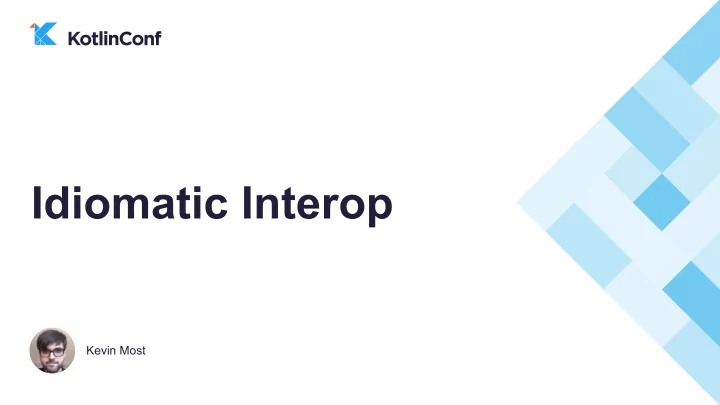

Nullability Annotations ! interface Request<T> {A Response<T> execute(); }B interface Response<T> {C @Nullable T getValue(); }D val request: Request<User> = getUser (id) request.execute(). value .displayableName
Nullability Annotations ! • Annotating everything is super-tedious kmost@kmost: ~/work/foursquare-android dev $ rg "@NonNull" --count --no-filename | paste -d+ -s - | bc 759 kmost@kmost: ~/work/foursquare-android dev $ rg "@Nullable" --count --no-filename | paste -d+ -s - | bc 475
Nullability Annotations ! static List<String> getUsers(); getUsers() // (Mutable)List<String!>!
Nullability Annotations ! @NonNull static List<String> getUsers(); getUsers() // (Mutable)List<String!>!
Nullability Annotations ! @NonNull static List<String> getUsers(); getUsers() // (Mutable)List<String!>
Nullability Annotations ! @NonNull static List<@NonNull String> getUsers(); getUsers() // (Mutable)List<String!>
Nullability Annotations ! @NonNull static List<@NonNull String> getUsers(); getUsers() // (Mutable)List<String>
Nullability Annotations ! interface Request<T> {A Response<T> execute(); }B interface Response<T> {C @Nullable T getValue(); }D val request: Request<User> = getUser (id) request.execute(). value .displayableName
Nullability Annotations ! interface Request<T> {A Response< A @Nullable T> execute(); }B interface Response<T> {C T getValue(); }D val request: Request<User> = getUser (id) request.execute(). value .displayableName
Nullability Annotations ! interface Request<T> {A Response<T> execute(); }B interface Response<@Nullable T> {C T getValue(); }D val request: Request<User> = getUser (id) request.execute(). value .displayableName
Nullability Annotations ! interface Request<T> {A Response<T> execute(); }B interface Response<T> { @Nullable T getValue(); }D val request: Request<User> = getUser (id) request.execute(). value .displayableName
Nullability Annotations ! interface Request<T> {A Response<T> execute(); }B interface Response<T> { @Nullable T getValue(); @Nullable Error<T> getError(); @Nullable HttpResponse getRawResponse(); }D val request: Request<User> = getUser (id) request.execute(). value .displayableName
Nullability Annotations ! interface Request<T> {A Response<T> execute(); }B interface Response<T> { @Nullable T getValue(); @Nullable Error<@Nullable T> getError(); @Nullable HttpResponse getRawResponse(); }D val request: Request<User> = getUser (id) request.execute(). value .displayableName
Nullability Annotations
Default Nullability Annotations • Added in Kotlin 1.1.50 • Specify default annotations: • Per package • Per class • Per method
Default Nullability Annotations dependencies { compile "com.google.code.findbugs:jsr305:3.0.2" } compileKotlin.kotlinOptions.freeCompilerArgs = [ "-Xjsr305-annotations=enable" ]
Default Nullability Annotations • JSR-305 comes with: • @ParametersAreNonnullByDefault • @ParametersAreNullableByDefault • Annotate a package to make all parameters for all functions non-null or nullable by default
Annotating a package package-info.java @ParametersAreNonnullByDefault package com.example.kotlinconf;
DIY Default Nullability Annotations • You're not limited to @ParametersAreNonnullByDefault • You can make your own nullability annotations • Let's look at the source for @ParametersAreNonnullByDefault
DIY Default Nullability Annotations ParametersAreNonnullByDefault.java @Nonnull @TypeQualifierDefault(ElementType. PARAMETER ) public @interface ParametersAreNonnullByDefault {}
DIY Default Nullability Annotations ParametersAreNonnullByDefault.java @Nonnull @TypeQualifierDefault(ElementType. PARAMETER ) public @interface ParametersAreNonnullByDefault {}
DIY Default Nullability Annotations FieldsAreNonnullByDefault.java @Nonnull @TypeQualifierDefault(ElementType. FIELD ) public @interface FieldsAreNonnullByDefault {}
DIY Default Nullability Annotations FieldsAreNonnullByDefault.java @Nonnull @TypeQualifierDefault(ElementType. FIELD ) public @interface FieldsAreNonnullByDefault {}
DIY Default Nullability Annotations FieldsAreNullableByDefault.java @Nullable @TypeQualifierDefault(ElementType. FIELD ) public @interface FieldsAreNullableByDefault {}
DIY Default Nullability Annotations FieldsAreNullableByDefault.java // not quite @Nullable @TypeQualifierDefault(ElementType. FIELD ) public @interface FieldsAreNullableByDefault {}
DIY Default Nullability Annotations FieldsAreNullableByDefault.java @CheckForNull // not quite @TypeQualifierDefault(ElementType. FIELD ) public @interface FieldsAreNullableByDefault {}
Living the dream package-info.java @ParametersAreNonnullByDefault @FieldsAreNullableByDefault @MethodsReturnNullableByDefault package com.example.kotlinconf;
Nulls in libraries • These solutions only work if you control the code in question • How do you deal with Java libs that have null everywhere? • ex: Android
Nulls in libraries • Ask your library maintainers
Nulls in libraries • Submit your own PR • Annotations are easy and low-risk • Even if you "know" the nullability of members, letting the compiler enforce it for you is better
Lambdas and SAMs
Lambdas and SAMs • Kotlin lambdas compile to a functional interface in Java • () -> R becomes Function0<R> • (T) -> R becomes Function1<T, R> • Java SAMs compile to a special syntax in Kotlin • SAMName { ... }
SAMs • Unfortunately, Kotlin SAMs currently don't o ff er SAM syntax in Kotlin • Right now, it's best to keep your SAM types in Java
SAMs public interface JavaSAM { void onClick(View view); } val sam = JavaSAM { view -> ... }
SAMs interface KotlinSAM { fun onClick(view: View) }B val sam = JavaSAM { view -> ... }
SAMs interface KotlinSAM { fun onClick(view: View) }B val sam = KotlinSAM { view -> ... }
SAMs interface KotlinSAM { fun onClick(view: View) }B val sam = KotlinSAM { view -> ... }
SAMs interface KotlinSAM { fun onClick(view: View) }B val sam = object : KotlinSAM { override fun onClick(view: View) { ... } }
"The other two [collection literals and SAM conversions] seem tractable in the foreseeable future"
Lambda signatures • Lambdas with receivers exported with receiver as 1st param • Nullability of types is lost in Java! • (Foo) -> Unit is equivalent to Foo?.() -> Unit from Java's perspective
Special Types
Special Types • Most types are mapped between Java and Kotlin • There are exceptions: • Unit • Nothing
Unit • Unit can be mapped to void in most cases in Java • It cannot, however, if Unit is the selected type for a generic • Ex: Lambdas. Java signature FunctionN<Args, Unit> • Java has to: return Unit.INSTANCE;
Nothing • Nothing is the subtype of all other types • No instances exist, not even null • So a Nothing function can never return; must throw/loop • No type exists like this in Java
Recommend
More recommend